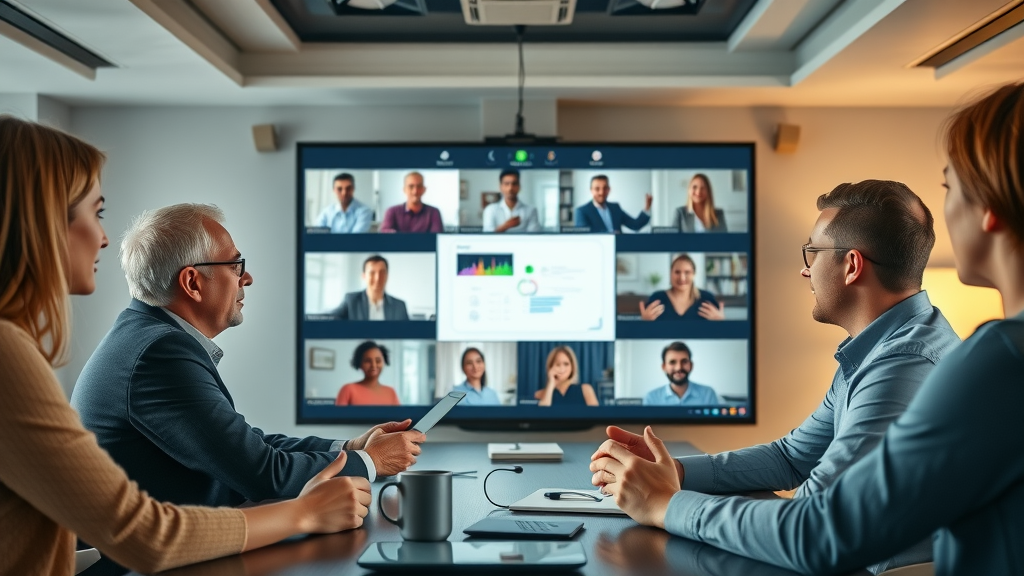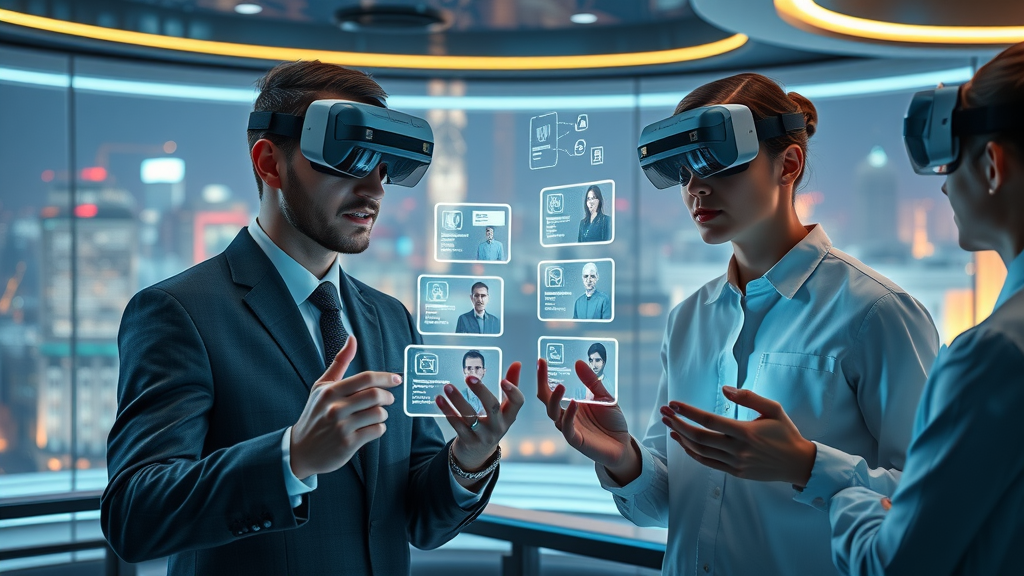Did you know that 97% of millennials rely on digital communication every single day? As our world accelerates into a hyper-connected era, the ability to navigate digital tools and communication channels can define your success—professionally and personally. From remote work to connecting with your target audience across global media platforms, mastering this transformation isn’t just an option; it’s essential to thrive. Read on to discover how you can sharpen communication skills and unlock new opportunities in the digital age!
Did You Know? 97% of Millennials Rely on Digital Communication Daily
In today’s world, it’s hard to imagine a day without digital communication, especially for younger generations. Millennials, more than any prior generation, are proficient in leveraging digital platforms for almost everything—from connecting with friends to advancing their careers. Whether through instant messaging, video calls, or social media platforms , digital communication serves as the backbone for how they share info, send messages , and build both professional and personal relationships.
Recent research shows that 97% of millennials interact on digital channels daily, reflecting a shift in communication behaviors that’s shaping organizations worldwide. This reliance has made it easier not only to reach broader audiences but also to speed up information sharing and support remote work. As digital communication channels become second nature, cultivating strong communication skills to maximize their value becomes a priority for anyone eager to remain competitive and connected in our constantly evolving digital landscape.

What You Will Gain: Navigating the Future with Digital Communication
Mastering digital communication unlocks endless possibilities for every professional, leader, and entrepreneur determined to thrive in a dynamic virtual world. By learning how to utilize diverse communication channels , you’ll develop the expertise to connect, collaborate, and share information quickly and effectively. These skills are critical for adapting to ongoing changes in remote work, evolving communication methods, and the expanding reach of media platforms.
This guide will show you how to harness digital communication tools to strengthen your professional relationships, build your brand, and sharpen your impact. You’ll also discover how to fine-tune your messaging to cater to your target audience , regardless of location or time zone, and how to benefit from cutting-edge innovations to stay ahead in your field.
- Master the essentials of digital communication and communication skills
- Strategies to leverage social media, instant messaging, and video conferencing
- Best practices for effective remote work and optimizing communication channels
- Insights into the future of digital communication
Understanding Digital Communication: Definition and Impact
Digital communication refers to the exchange of information through electronic channels—such as email, instant messaging, social media, and video conferencing—instead of traditional face-to-face or phone call methods. Today’s digital communication is not just about efficiency; it allows people worldwide to share information instantly, making it easier for organizations to reach their target audience , enable remote work, and foster stronger connections amongst global teams.
The impact of digital communication extends far beyond convenience. It’s made it easier for businesses to respond to customer feedback in real-time, provides robust networking platforms for professionals, and helps maintain productivity when teams cannot be together physically. With the growing prevalence of digital tools like project management software and collaboration platforms, the effectiveness of communication efforts now hinges on the thoughtful integration of technology and human interaction.

| Communication Channel | Description | Use Case |
|---|---|---|
| Asynchronous, professional | Business correspondence | |
| Social Media | Public, real-time sharing | Brand promotion |
| Instant Messaging | Fast, informal exchanges | Team updates |
| Video Conferencing | Face-to-face, virtual | Remote meetings |
Core Communication Skills for Effective Digital Communication
Developing strong communication skills is critical for anyone determined to excel in the age of digital communication . While digital platforms increase the speed and diversity of communication methods , they also demand specific skills to ensure your message is clear, concise, and received as intended. Active listening plays a pivotal role in every conversation, requiring participants to not only intake information but also to demonstrate attentiveness—especially in video conferencing or instant messaging environments where cues can be easily missed.
Another key skill is the interpretation of tone . Without the benefit of voice inflections or facial expressions in text-based exchanges, messages are prone to misinterpretation. Understanding non-verbal cues during video calls and adapting your approach in real time enables deeper engagement during virtual meetings. Additionally, being able to express yourself clearly in written form—whether crafting emails, messaging via social media, or communicating within networking platforms—is fundamental for nurturing trust and delivering effective communication online.

- Active Listening
- Tone Interpretation
- Clear Written Expression
Exploring Communication Channels in the Digital Age
Modern digital communication offers an abundance of channels, each with unique strengths and challenges. Instant messaging stands out for its speed and informality, making it ideal for quick team updates and collaborative brainstorming. Social media provides an unparalleled platform for connecting with a mass audience in real time, facilitating brand engagement and instant feedback. Networking platforms, on the other hand, are the go-to spaces for professionals to build connections, showcase expertise, and explore new opportunities.
Navigating these diverse digital channels requires intentionality. A successful communication strategy involves selecting the right mix of platforms for your target audience, adapting your style for each channel, and being aware of the potential pitfalls. For example, while instant messaging fosters fast dialogue, it can lead to misinterpretation without clear context. Social media’s broad reach amplifies your message but also heightens the risk of public miscommunication. Staying mindful of information overload on networking platforms is vital for productive communication efforts.

| Channel | Strength | Common Pitfall |
|---|---|---|
| Instant Messaging | Speed | Misinterpretation |
| Social Media | Broad Reach | Public Miscommunication |
| Networking Platforms | Professional Connections | Information Overload |
The Role of Social Media in Digital Communication
Social media platforms have redefined how we share info, engage with our target audience, and manage our professional reputation. With millions of users worldwide, digital communication via social media connects businesses and individuals instantly, regardless of geographical boundaries. These platforms enable community building, allowing brands to foster loyalty and advocacy by nurturing meaningful conversations and inclusive online spaces.
One standout benefit is the channel’s ability to encourage instant feedback. Whether it’s responding to a trending topic, customer inquiry, or industry development, social media allows for real-time adaptation and customer-centric decision-making. Furthermore, effective use of these media platforms is vital for multi-platform engagement—meaning your message reaches wider audiences via various digital tools, adapting to where your audience spends their time online, and reinforcing consistent, trusted messaging across every interaction.

- Facilitating Community Building
- Instant Feedback Channels
- Reputation Management
- Multi-platform Engagement
Instant Messaging: Transforming Everyday Communication
Instant messaging has become one of the most influential digital communication tools , dramatically transforming how teams, families, and friends share info. Its real-time nature “ made it easier ” to resolve problems quickly, send messages with clarity, and build collaborative workflows, especially in remote work setups. Whether it’s a simple team update, a project management alert, or a check-in with a colleague across the globe, instant messaging breaks down barriers of distance and scheduling.
However, the utility of instant messaging comes with the expectation of professionalism and clear intent. As the quote below reminds us, clarity and respect remain non-negotiable for success in a global, digital-first environment. Mastering this form of digital communication is essential for keeping project teams aligned, management up-to-date, and organizations agile in response to new challenges.
“Instant messaging enables seamless global collaboration but demands clarity and professionalism at all times.” – Digital Workplace Expert
These platforms are also ideal for informal check-ins and spontaneous brainstorming, but they should always be approached with strategic communication skills to avoid misunderstandings or an overwhelming barrage of notifications.
Maximizing Video Conferencing for Digital Communication Success
Video conferencing has become a cornerstone communication method for organizations navigating remote work, cross-border collaboration, and global client management. This form of digital communication recreates the value of face-to-face interaction, enabling teams to build rapport, resolve conflicts, and brainstorm ideas in real time. Virtual team meetings connect employees across locations, while webinars and online workshops offer interactive learning and business development opportunities.
Success with video conferencing hinges on adopting best practices such as clear agendas, strong technical setups, and skilled facilitation. Well-run video calls can replace hours of email exchanges, flatten hierarchies by giving everyone a voice, and foster inclusivity in decision-making processes. Onboarding sessions and client consultations also become more effective, as participants can directly share information, demonstrate digital tools, and provide real-time support.

- Virtual Team Meetings
- Webinars & Workshops
- Onboarding Sessions
- Client Consultations
Remote Work: Leveraging Digital Communication for Productivity
The rise of remote work has underscored the value of digital communication tools for maintaining productivity and team morale. Employees leverage a blend of asynchronous (like email and project management software) and synchronous channels (such as instant messaging and video calls) to overcome the challenges of distance, time zones, and limited face-to-face interaction. Clear communication strategies ensure that everyone is on the same page, streamlining collaboration regardless of physical proximity.
To build effective remote work environments, organizations prioritize document collaboration tools, virtual team building activities, and digital platforms providing real-time feedback. These approaches help bridge communication gaps, boost accountability, and promote a healthy team culture. Successful remote teams don’t just rely on the latest digital tools—they cultivate strong communication skills, ensuring each member can contribute, collaborate, and innovate effectively from anywhere.

- Asynchronous & Synchronous Communication
- Document Collaboration Tools
- Team Building Activities Online
Optimizing Your Communication Channels for Maximum Impact
With an ever-expanding array of digital channels , mastering the art of choosing the right communication method for your context is more important than ever. A communication strategist’s role often involves analyzing digital channel analytics to determine which platforms best resonate with their target audience, deliver messages clearly, and drive desired actions. By evaluating performance data, organizations can pinpoint the most impactful messaging strategies while minimizing communication pitfalls such as information overload or misinterpretation.
Optimization also involves regular assessment and adaptation—what works for one team or audience may not be effective for another. Streamlining communication channels involves continuous learning, embracing new technologies, and remaining agile to capitalize on emerging trends. The end goal is to foster efficient and meaningful connections, boost productivity, and support ongoing growth in both traditional and remote work settings.

Future of Digital Communication: Trends and Innovations
The future of digital communication promises vast innovations set to redefine how we share information, collaborate, and connect. Advances in artificial intelligence introduce AI-powered assistants capable of automating tasks, analyzing communication efforts, and enhancing workplace efficiency. The growing use of augmented and virtual reality (AR/VR) is making meetings more immersive, offering a sense of presence even when participants are thousands of miles apart.
Another trend is the prioritization of privacy and data security. Enhanced privacy protocols build trust with your target audience and ensure compliance with stringent data regulations. As technology evolves, organizations and professionals must remain vigilant, continually upskilling to remain relevant and prepared for the next chapter of the digital age.

| Trend | Potential Impact |
|---|---|
| AI Assistants | Enhanced Efficiency |
| AR/VR Meetings | Deeper Engagement |
| Enhanced Privacy | Greater Trust |
Benefits of Digital Communication in Business and Beyond
The benefits of digital communication are far-reaching and transformative for businesses, educational institutions, and individuals alike. First and foremost, it delivers global reach—enabling teams and organizations to connect, communicate, and collaborate with anyone, anywhere, in real time. This is coupled with significant cost efficiency, as there’s less need for expensive travel or physical resources to share information effectively.
With 24/7 availability, digital communication channels empower organizations to operate across multiple time zones, serve their audience more responsively, and make data-driven decisions by leveraging analytics and feedback. These advantages extend beyond business, reshaping education, healthcare, and social interaction, making the world truly interconnected through digital platforms.
- Global Reach
- Cost Efficiency
- 24/7 Availability
- Data-Driven Decisions
Most Effective Strategies to Develop Digital Communication Skills
To truly excel in digital communication , continuous personal development is essential. One effective strategy is dedicated practice—actively participating in group chats, leading online meetings, and collaborating on projects using various digital tools. Seeking feedback helps refine tone, clarity, and responsiveness, which are vital in virtual spaces. Setting aside time to learn about new platforms—whether it’s a niche networking platform, project management software, or an emerging social media app—expands both your reach and flexibility.
Online courses and webinars provide structured learning paths, helping you hone your skills in real-world contexts. Role-playing scenarios and simulated communications can also boost your ability to interpret non-verbal cues and improve digital body language. By nurturing adaptability and empathy, you’ll strengthen your capability to forge more meaningful, professional connections through digital channels.
Challenges of Digital Communication and How to Overcome Them
While digital communication offers many benefits, it also presents distinct challenges. Common issues include misinterpretation of tone, information overload, and digital fatigue. With a deluge of messages flooding inboxes, chat groups, and project management dashboards, key messages can be lost or misunderstood. Overcoming these hurdles requires a blend of communication skills, technological know-how, and strategic time management.
To reduce misunderstandings, embrace clear and structured messaging, encourage regular feedback, and foster a culture of empathy and patience. Implementing digital tools like collaboration software and calendar management optimizes communication efforts and helps teams stay organized. The following quote highlights how the blend of clarity, empathy, and adaptability makes all the difference in mastering digital transformation:
“The real art of digital communication lies in blending clarity, empathy, and adaptability.” – Industry Thought Leader
Establishing consistent communication policies and encouraging breaks can also prevent burnout and ensure your teams remain engaged and effective.
Ethics and Security in Digital Communication Practices
In an era where data breaches and privacy concerns dominate headlines, ethical and secure digital communication is non-negotiable. Organizations must employ data encryption for all sensitive exchanges, set clear, transparent communication policies, and foster a culture that respects confidentiality. Transparent policies establish trust within teams and reassure clients or stakeholders that their data is handled responsibly.
Respecting privacy and adhering to ethical standards in every communication method—be it email, instant messaging, or cloud-based document sharing—minimizes risks and secures your reputation as a trusted communicator. These best practices are foundational to long-term success for any individual or organization operating in the digital space.
- Data Encryption
- Transparent Communication Policies
- Respect for Confidentiality
Digital Communication: Real-World Success Stories
Many companies and individuals have achieved remarkable results by embracing digital communication . For example, global firms like IBM and Twitter have transitioned seamlessly to remote work models, leveraging a blend of instant messaging, video conferencing, and social media to maintain productivity and brand relevance. Educational organizations use virtual classrooms and collaborative digital tools to engage students worldwide, breaking geographical and economic barriers.
Startups and nonprofits also harness networking platforms and project management software to scale their outreach, run virtual campaigns, and connect with stakeholders in real time. By adopting a mix of innovative communication channels and cultivating strong communication skills, these organizations demonstrate how strategic digital transformation drives measurable results and long-term growth.
What is meant by digital communication?
Digital communication refers to the exchange of information using electronic tools and technologies. This includes everything from emails and instant messages to social media and video conferencing. Unlike traditional communication methods such as phone calls or face-to-face meetings, digital communication enables real-time, asynchronous, and global interactions, giving you the flexibility to connect and share info from virtually anywhere. In today’s landscape, it’s a foundational skill for business, education, and social interaction.
What are 5 examples of digital communication?
Five common examples of digital communication are:
- Email – For formal business correspondence and documentation
- Social media platforms – Like Facebook, Instagram, LinkedIn, and Twitter, used for mass communication and brand engagement
- Instant messaging apps – Such as Slack, WhatsApp, or Microsoft Teams, perfect for rapid team collaboration and updates
- Video conferencing tools – Zoom, Google Meet, or Skype, essential for virtual meetings and remote work
- Online forums or discussion boards – Communities where people share information, solve problems, or seek advice on niche topics
What are the four types of digital communication?
There are four primary types of digital communication:
- Text-based communication – Includes emails, chats, and forum posts
- Audio-based communication – Such as phone calls and voice messages over digital platforms
- Video-based communication – Encompasses video calls, conferences, and webinars
- Visual communication – Images, infographics, and videos shared across social media or messaging channels
Each type serves different needs and is best used depending on context, target audience, and desired impact.
Is digital communication a good degree?
Yes, digital communication is a valuable degree in today’s job market. The demand for professionals skilled with digital tools, communication channels, and content creation continues to rise across all industries. Graduates can pursue careers in marketing, public relations, journalism, digital strategy, and more. With businesses increasingly reliant on digital platforms and remote work, those with advanced communication skills and a deep understanding of modern media platforms become invaluable assets to any organization.
Frequently Asked Questions on Digital Communication
-
How does digital communication differ from traditional communication?
Digital communication uses electronic tools and platforms, allowing real-time and asynchronous interactions from anywhere in the world. In contrast, traditional communication often relies on physical presence (face-to-face meetings) or fixed communication methods (phone call), limiting flexibility and reach. -
What skills are essential for mastering digital platforms?
Key skills include clear written expression, active listening during virtual meetings, tone interpretation in digital messages, adaptability to new technologies, and ethical use of communication tools. Developing these ensures effective communication across all digital platforms. -
How to handle remote work challenges with digital tools?
Effective remote work depends on selecting the right blend of asynchronous and synchronous communication methods, using collaboration and project management software, and setting clear communication norms. Regular check-ins and prioritizing team-building activities online help maintain morale and alignment.
Key Insights to Remember about Digital Communication
- Digital communication skills are fundamental to success in the digital age
- Diverse platforms require adaptable strategies
- Ethical and secure practices foster trust and reputation
- Continuous learning drives digital communication proficiency
Unlock Opportunities with Digital Communication
Embrace digital communication as your pathway to personal growth, meaningful collaboration, and sustained professional success. Whether you’re leading a team, building a brand, or connecting across cultures, the skills you develop today will define your impact tomorrow.
To deepen your understanding of digital communication, consider exploring the following resources:
- “Digital Communication: What It Is and Where It’s Headed” ( medium.com )
This article provides a comprehensive overview of digital communication, detailing various types such as email, instant messaging, video conferencing, and social media. It also discusses the benefits of digital communication, including increased speed, accessibility, cost-effectiveness, and environmental friendliness.
- “Digital Communication: Transforming Connections” ( trueconf.com )
This resource delves into the advantages of digital communication, highlighting aspects like convenience, cost-effectiveness, improved efficiency, and enhanced collaboration. It also explores various digital communication channels, including email, instant messaging, and video conferencing, and discusses future trends such as advancements in AI, AR/VR, and 5G technology.
By engaging with these materials, you’ll gain valuable insights into the evolution, benefits, and future directions of digital communication, equipping you to navigate and leverage these tools effectively in both personal and professional contexts.
 Add Row
Add Row  Add
Add 




Write A Comment